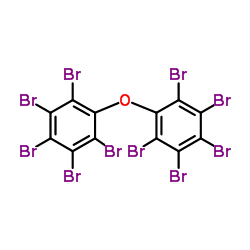Decabromodiphenyl Oxide

Decabromodiphenyl Oxide structure
|
Common Name | Decabromodiphenyl Oxide | ||
|---|---|---|---|---|
| CAS Number | 1163-19-5 | Molecular Weight | 959.168 | |
| Density | 3.0±0.1 g/cm3 | Boiling Point | 425 ºC | |
| Molecular Formula | C12Br10O | Melting Point | 302.5 ºC | |
| MSDS | N/A | Flash Point | 241.4±28.6 °C | |
| Symbol |




GHS02, GHS07, GHS08, GHS09 |
Signal Word | Danger | |
|
Estimating stepwise debromination pathways of polybrominated diphenyl ethers with an analogue Markov Chain Monte Carlo algorithm.
Chemosphere 114 , 187-94, (2014) A stochastic process was developed to simulate the stepwise debromination pathways for polybrominated diphenyl ethers (PBDEs). The stochastic process uses an analogue Markov Chain Monte Carlo (AMCMC) algorithm to generate PBDE debromination profiles. The acce... |
|
|
Transport of persistent organic pollutants across the human placenta.
Environ. Int. 65 , 107-15, (2014) Prenatal life is the most sensitive stage of human development to environmental pollutants. Early exposure to persistent organic pollutants (POPs) may increase the risk of adverse health effects during childhood. The mechanisms of transference of POPs during ... |
|
|
Food web-specific biomagnification of persistent organic pollutants.
Science 317 , 236-9, (2007) Substances that accumulate to hazardous levels in living organisms pose environmental and human-health risks, which governments seek to reduce or eliminate. Regulatory authorities identify bioaccumulative substances as hydrophobic, fat-soluble chemicals havin... |
|
|
The effect of the indoor environment on the fate of organic chemicals in the urban landscape.
Sci. Total Environ. 438 , 233-41, (2012) To assess the effect of the indoor environment on the urban fate of organic chemicals, an 8-compartment indoor-inclusive steady state multimedia chemical fate model was developed. The model includes typical urban compartments (air, soil, water, sediment, and ... |
|
|
Persistent organic pollutants in the Scheldt estuary: environmental distribution and bioaccumulation.
Environ. Int. 48 , 17-27, (2012) Levels of polychlorinated biphenyls (PCBs), polybrominated diphenyl ethers (PBDEs) and organochlorine pesticides (OCPs) were determined in the sediment and several species (European flounder, Platichthys flesus; common sole, Solea solea; Chinese mitten crab, ... |
|
|
Morphology, spatial distribution, and concentration of flame retardants in consumer products and environmental dusts using scanning electron microscopy and Raman micro-spectroscopy.
Environ. Int. 59 , 16-26, (2013) We characterized flame retardant (FR) morphologies and spatial distributions in 7 consumer products and 7 environmental dusts to determine their implications for transfer mechanisms, human exposure, and the reproducibility of gas chromatography-mass spectrome... |
|
|
Biodegradation of decabromodiphenyl ether (BDE-209) by white-rot fungus Phlebia lindtneri.
Chemosphere 110 , 70-7, (2014) This work investigated degradation of decabromodiphenyl ether (BDE-209) by Phlebia lindtneri under the influence of glucose and heavy metals (Cd(2+), Cu(2+) or Pb(2+)). The results showed that adding glucose could markedly promote BDE-209 biodegradation. In t... |
|
|
Efficient oxidative debromination of decabromodiphenyl ether by TiO2-mediated photocatalysis in aqueous environment.
Environ. Sci. Technol. 47(1) , 518-25, (2013) Direct evidence was first demonstrated for the oxidative degradation of decabromodiphenyl ether (BDE209) in aqueous TiO(2) dispersions under UV irradiation (λ > 340 nm). BDE209 was hardly debrominated over TiO(2) in UV-irradiated acetonitrile dispersions, but... |
|
|
Ecotoxicological effects of decabromodiphenyl ether and cadmium contamination on soil microbes and enzymes
Ecotoxicol. Environ. Saf. 82 , 71-9, (2012) The ecotoxicological effects of decabromodiphenyl ether (BDE209) and cadmium (Cd) contamination on soil culturable microbial population, enzyme activity and bacterial community structure were investigated. Results of the indoor incubation test runs performed ... |
|
|
Concentrations and sources of an emerging pollutant, decabromodiphenylethane (DBDPE), in sewage sludge for land application.
J. Environ. Sci. (China) 24(3) , 558-63, (2012) The presence of an emerging brominated flame retardant, decabromodiphenylethane (DBDPE), has been confirmed in Spanish sewage sludge. Thirty one samples from different urban wastewater treatment plants (WWTPs) were analyzed for this brominated flame retardant... |